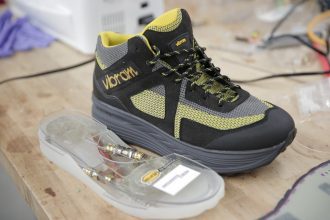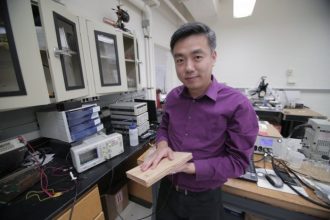Contributing writer for Wake Up World
If engineers at the University of Wisconsin-Madison have anything to say about sustainable energy, we may soon be generating electricity by the simple task of walking. The ultimate in green design, the team has developed a unique flooring which harnesses footstep energy, while also using a completely renewable and economical material.
But flooring isn’t the only option for producing electricity with human movement. Another group of mechanical engineers at the university have also developed innovative, foot-powered technology — only this time, using shoes.
Generating Clean Energy with Human Footsteps
Lead researcher of the project, Xudong Wang, believes his special flooring could revolutionize how we approach energy. Using a common waste material — wood pulp, which is partly made of cellulose nanofibers — the flooring takes advantage of the electrical charge that’s created when chemically treated fibers come in contact with untreated fibers. When these nanofibers are embedded within flooring, they product energy that can be used to power lighting or charge batteries. And because wood pulp is inexpensive, abundant and renewable — not to mention a waste product of industry — the flooring is a very affordable option to generate clean energy.
[pro_ad_display_adzone id=”110028″]
While technology to harness footstep energy has been available for quite some time, it’s costly, environmentally unfriendly and impractical for use on a large scale. Reports the science and innovation website Grendz:
“Wang’s research centers around using vibration to generate electricity. For years, he has been testing different materials in an effort to maximize the merits of a technology called a triboelectric nanogenerator (TENG). Triboelectricity is the same phenomenon that produces static electricity on clothing. Chemically treated cellulose nanofibers are a simple, low-cost and effective alternative for harnessing this broadly existing mechanical energy source.”
The technology, dubbed “roadside energy harvesting” — could rival, or even surpass — solar and wind for energy production, since it doesn’t rely on specific weather conditions. Researchers view the ground as holding enormous energy potential — far greater than fossil fuel reserves.
“Roadside energy harvesting requires thinking about the places where there is abundant energy we could be harvesting,” Wang says. “We’ve been working a lot on harvesting energy from human activities. One way is to build something to put on people, and another way is to build something that has constant access to people. The ground is the most-used place.”
Take for example high traffic areas like stadiums and malls. Wang points out that these places can produce significant amounts of energy. The floor could even be designed with several layers of the slim, millimeter thick material to further increase energy output.
“Our initial test in our lab shows that it works for millions of cycles without any problem. We haven’t converted those numbers into year of life for a floor yet, but I think with appropriate design it can definitely outlast the floor itself.”
Flooring isn’t the only area of research regarding human-generated electricity at the university. A team of mechanical engineers have developed a shoe that captures the energy of human motion with every step, which in turn can power small electronic mobile devices.
Tapping Into a Small Amount of Energy for Big Returns
Tom Krupenkin, a professor of mechanical engineering at UW-Madison, and J. Ashley Taylor, a senior scientist in UW-Madison’s Mechanical Engineering Department, say their team has developed a “footwear-embedded energy harvester that captures energy produced by humans during walking and stores it for later use.”
The technology could be particularly useful people living in remote areas and those who live in developing countries, where access to electrical power grids is lacking. The advance could also be used by the military, because, as it stands, soldiers are burdened with carrying heavy batteries to power GPS units, radios and night-vision goggles while in the field.
“Human walking carries a lot of energy,” Krupenkin says. “Theoretical estimates show that it can produce up to 10 watts per shoe, and that energy is just wasted as heat. A total of 20 watts from walking is not a small thing, especially compared to the power requirements of the majority of modern mobile devices.”
[pro_ad_display_adzone id=”110030″]
Tapping into just a small amount of this energy can power a range of mobile devices — like smartphones, tablets, laptop computers and flashlights. To put this in perspective, an average smartphone requires less than two watts of energy.
For all that, traditional approaches of energy-harvesting and conversion from walking weren’t efficient. So the team developed a technology that uses “reverse electrowetting” — a process that Krupenkin and Taylor pioneered in 2011. With this approach, as a conductive liquid interacts with a nanofilm-coated surface, the mechanical energy is directly converted into electrical energy.
“The researchers [also] developed what they call the “bubbler” method, which they described in their Scientific Reports study. The bubbler method combines reverse electrowetting with bubble growth and collapse.
The researchers’ bubbler device — which contains no moving mechanical parts — consists of two flat plates separated by a small gap filled with a conductive liquid. The bottom plate is covered with tiny holes through which pressurized gas forms bubbles. The bubbles grow until they’re large enough to touch the top plate, which causes the bubble to collapse.
The speedy, repetitive growth and collapse of bubbles pushes the conductive fluid back and forth, generating electrical charge.”
The harvester can directly power various mobile devices through a charging cable, or have an integrated Wi-Fi hot spot, which acts as a “middle man” between mobile devices and wireless networks. The latter example “dramatically cuts the power requirements of wireless mobile devices, and can make a cellphone battery last 10 times longer between charges.”
At some point in the future, Krupenkin and Taylor hope to partner with industry and commercialize the technology through their startup, InStep Nano Power.
Article sources:
About the author:
 Carolanne Wright enthusiastically believes if we want to see change in the world, we need to be the change. As a nutritionist, natural foods chef and wellness coach, Carolanne has encouraged others to embrace a healthy lifestyle of organic living, gratefulness and joyful orientation for over 13 years.
Carolanne Wright enthusiastically believes if we want to see change in the world, we need to be the change. As a nutritionist, natural foods chef and wellness coach, Carolanne has encouraged others to embrace a healthy lifestyle of organic living, gratefulness and joyful orientation for over 13 years.
Through her website Thrive-Living.net, she looks forward to connecting with other like-minded people from around the world who share a similar vision. You can also follow Carolanne on Facebook, Twitter and Pinterest.
Recommended articles by Carolanne Wright:
- Antibiotics Shown to Impair Memory, Stop Growth of New Brain Cells
- Renowned Harvard Psychologist Says ADHD is Largely a Fraud
- Plastic Waste in the Ocean Will Outnumber Fish by 2050
- Monsanto Charged with Crimes Against Nature and Humanity – Set to Stand Trial in 2016
- Plastic-Eating Mushroom Discovered in the Amazon Rainforest — A Solution for Our Trash Saturated World?
- Over 100 Scientific Studies Agree: Cannabis Annihilates Cancer
- Why Every Parent Should Consider Unschooling
- First U.S. City Produces More Electricity Than It Uses — With 100% Renewable Technology
- If You Care About Animals and the Earth, Here’s Why You Need to Boycott Palm Oil Immediately
- Basic Income Guarantee: A Surprisingly Cost-Effective Method for Eliminating Poverty
- Almost Free Energy? For the Cost an iPhone, You Can Now Buy a Wind Turbine to Power Your Entire House
- Why You Should Have a Himalayan Crystal Salt Lamp in Every Room of Your House
[pro_ad_display_adzone id=”110027″]








